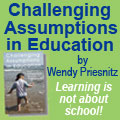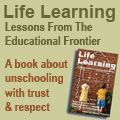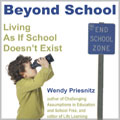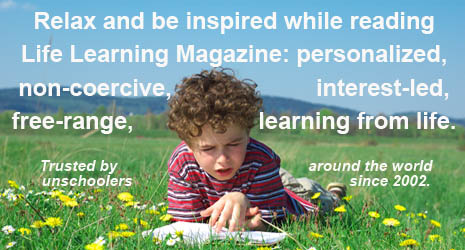
Learning is Not Something That's Done to You
by Wendy Priesnitz
an excerpt from the book Challenging Assumptions in Education: From Institutionalized Education to a Learning Society
“You cannot teach a person anything; you can only help him find it within himself.” ~Galileo
Perhaps the most basic assumption our society makes about education is that learning can and should be produced in people. This assumption leads to another one: Learning is the result of treatment by an institution called school.
We assume that people – especially children – do not want to learn and will not learn if left to their own devices. So we force children to gather together in one place for long hours with others of the same age, so that we can “educate” them. Even many people who reject traditional schooling in favor of homeschooling believe that education must be “done to” children. They continue the process of manipulating children to learn, as well as judging and processing them in a variety of ways, then diagnosing them as having a problem or even an illness if they don’t learn what the adults have decided they need to learn.
Unfortunately for children, this assumption is no more valid than the one which says wellness results from treatment by a hospital. One may get well in a hospital and there are some situations where a hospital stay may be the only way to get well. But there are also many examples where hospitals have hindered the healing process or where relatively well people have become ill in hospitals, either through mistreatment or by catching other people’s diseases. Most people would be healthier if they took responsibility for their own well-being, rather than rushing off to be treated by an institution every time they have a health problem.
Similarly, people do learn in schools. However, most schools are not the only – or for many people, the best – environment for learning. And that is because they focus on teaching rather than on learning. Human beings do not need to be taught in order to learn. We are born interacting with and exploring our surroundings. Babies are active learners, their burning curiosity motivating them to learn how the world works. And if they are given a safe and supportive environment, they will continue to learn hungrily and naturally – in the manner and at the speed that suits them best. In fact, you cannot stop children (or adults, for that matter!) learning from everything they experience – unless that instinct has been destroyed in them. Children are always experimenting with cause and effect. And they are always soaking up information from their environment – learning to walk, talk, and do many other amazing things.
Cognitive psychologist Alison Gopnik, who is co-author of a research study called “The Scientist in the Crib,” says babies’ brains are smarter, faster, more flexible and busier than adults’. Her research has confirmed that, contrary to traditional beliefs about children, toddlers think in a logical manner, arriving at abstract principles early and quickly. “They think, draw conclusions, make predictions, look for explanations and even do experiments,” she writes.
The late Robert White, Harvard developmental psychologist, called this instinct to learn an “urge toward competence.” What he meant was that we are born with the need to have an impact on our surroundings, to control the world in which we live. We do not just sit and wait for the world to come to us (unless we’ve been told to sit down, be quiet and wait). We actively try to interpret the world, to make sense of it. Of course, this drive to discover means we are constantly learning...and experiencing the pride that comes with having learned.
Some psychologists feel that the pleasure we take from this drive to learn is also its motivation. Perhaps this hedonistic aspect of self-directed learning is also its downfall! How can something so important be so much fun? Can learning really be so effortless? Unfortunately, by turning learning into forced drudgery – intentionally or not – schools suffocate the natural desire to discover and master the world.
What results is a kind of self-fulfilling prophesy. Because schools often suffocate this hunger to learn, learning appears to be difficult and we assume that children must be extrinsically motivated to do it. The tools of manipulation and motivation include rewards and a whole array of demeaningly “fun” exercises reproduced from boring workbooks. In reality, people do not need external rewards to learn. We do not learn things because the process is fun, but because what we learn allows us to accomplish something. And that accomplishment is sufficient reward.
Nevertheless, there is more to learning than meets the eye. It is actually a very sophisticated mental process. No matter what the topic is or how motivated we are, people of all ages learn best when there is time for research, for digression, for processing the information, for immersion in the project, for spontaneous activities or even sidetracks. We learn by muddling through problems and discovering the satisfaction of accomplishment. Learning is a process of figuring things out, making connections, getting ideas and testing them, taking risks, making mistakes without fear of ridicule or embarrassment, and trying again. An optimum learning environment provides opportunities to explore, to investigate questions and ideas.
Discovery leads learners to find out about the world. Reading novels can spark an interest in history. Setting up a lemonade stand requires and develops a knowledge of arithmetic. Communicating at a distance with grandma hones creative writing skills. A conversation over the back fence can result in the enthusiastic pursuit of a common interest with a like-minded friend – not because two people share the same age but because they share a passion for a certain subject.
A real teacher is a facilitator, collaborator, and supporter of this learning process, rather than someone who attempts to create, control, or manipulate learning. This type of support requires respecting and trusting the learner; talking with them; providing opportunities for interaction with people and things; sharing and modeling learning; supporting the risk- and mistake-making processes; enriching the environment with books, pens, paper, and other materials; celebrating good ideas and satisfying accomplishments; and helping troubleshoot when things go wrong. It also means providing the time for children to investigate their own ideas, and being a flexible and patient observer of a process that does not always appear to be sequential or organized.
Schools are not usually designed for this sort of active learning. They can’t possibly present enough opportunities, time, space, or flexibility for self-directed learning to take place, in spite of the fact that some teachers and administrators will tell you this is exactly what they are doing.
Active learners can benefit from access to resource people but do not require motivation or coercion. Active learners do not need the forced guidance of someone else’s agenda or curriculum. They do not need formal lessons taught at predetermined hours on days set aside especially for learning. (They may chose formal lessons at some point, but that is their active choice.)
Nor does active learning require assessment or grading. The concepts of “passing” and “failing” are really only relevant to situations where education is thought of as a series of hurdles to be scaled, and where accountability is the bottom line from an economic efficiency perspective. Nobody needs tests or grades in order to learn.
When we interfere with and try to control or measure the natural learning process, we remove children’s pleasure in discovery and inhibit their fearless approach to problem-solving. We have all seen that sort of interference in action. My three-year-old daughter wanted to put her own shoes on. She proudly put the left shoe on the right foot, then determinedly spent ten minutes creating a massive knot in the laces. Her grandmother, not being able to watch any longer, said, “You’re doing it all wrong. Here, let Grandma do it for you!” My daughter burst into tears. Fortunately, I had the courage to intervene because the legacy of that type of “help” left me with a resistance to trying something new for fear of not being able to do it perfectly well the first time.
When people are fearful or confused, or have been convinced that something is too difficult or that they are too dumb, they shut down...and that's not conducive to learning. The surest way to make someone fearful of risk-taking is to demonstrate their chance of failing. What happened to me in school is “learned incompetence.” It is no wonder our schools are full of bored, frustrated, angry, passive children who have lost their ability – and desire – to question, experience and learn.
Those, however, are the lucky ones. Their less fortunate peers, whose frustration or lowered self-esteem leads them to misbehave, are diagnosed with mysterious learning “diseases” during their “treatment” at school. A cure is then prescribed, expectations for academic performance are lowered and the learning diseased children are often segregated from their peers. The “cure” is usually a dangerous drug like Ritalin.
Labeling children with one of these so-called “disorders” or “disabilities” is really blaming the victim, according to some psychologists. The system that has failed to educate these children then punishes them for not learning. In the past, these kids might have been labeled as “daydreamers” or “bundles of energy.” But they were seldom, if ever, thought to have a psychiatric illness just because they didn’t fit into a certain structure. In fact, these children are often quite creative, excelling in music, dance, writing, or inventing – when they are allowed to indulge in those activities
Although the institution of schooling may not be the best place for many children to learn, it has other important functions. Requiring children to meet together in dedicated buildings for a certain number of hours each weekday serves parents who need child care, teachers who like to work regular hours at challenging jobs, and everyone else in the industry that services the institution. But it is time to admit to ourselves that the industrial model on which we have based our school systems is not designed for the benefit of learners. Children have become the justification for and the product of the school industry. In that way, schools need children more than children need schools!
So now that we have challenged the assumption that real education can be done to people, with what do we replace it? We must begin at the beginning – by confronting our own feelings about learning. We must begin by separating what really contributes to learning from what schools say is helpful. And we must begin by trusting in children’s desire and ability to learn.
Then we must observe how our own children actively learn and provide them with environments where learning can happen. For many families, this will mean helping their children learn at home. But it also means that we must deschool our communities and perhaps all of society. Everyone – parents, non-parents, grandparents, teachers, politicians, the corporate sector – must take responsibility for creating and maintaining learning environments. This includes modeling the behavior; making the environment safe, stimulating, and respectful; providing access to requested resources; consoling when things go wrong; and celebrating when things go right. Then we must get out of the way and not meddle in the learning process unless we are invited. In fact, we need to trust people of all ages – family members, work colleagues, neighbors, and employees – to figure things out for themselves unless they ask for our help.
At the same time, we can work together in our communities to create a learning society that will eventually replace schools as we now know them. If we refer to Gardner’s model of the eight intelligences, we can begin to see that everyday life can easily provide a full-spectrum learning environment that appreciates individual differences and is suited to each child’s learning abilities and needs. We need to demand that our politicians use our tax money to fund libraries, museums, theaters, other community institutions – and yes, even school buildings – so they can afford to provide spaces for people of all ages to explore, interact, and learn (on their own initiative, of course).
Institutions should exist to be used, rather than to produce something. If they are effective, people will use them. If they are accessible and stimulating, they will naturally incubate self-organizing groups of individuals and families who cooperate to use the spaces and resources to provide experiences that nurture learning.
What we should not do is create new schools – be they charter schools, private schools, or home schools – which perpetuate the old assumptions of how children learn or who controls children’s lives.
Wendy Priesnitz has been a writer and editor since the mid-1970s. Along the way, she has mothered two school-free daughters, written more than a dozen books and contributed to many more, and founded Canada's first homeschooling support group. She is the founding editor of Life Learning Magazine. You can learn more about the book Challenging Assumptions in Education here.
Copyright © Life Media
Privacy Policy
  
  

|

